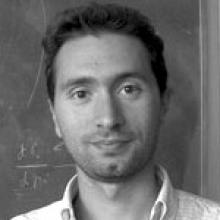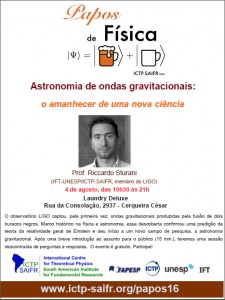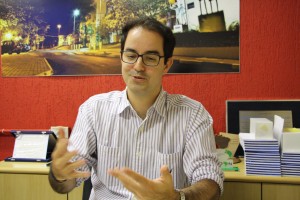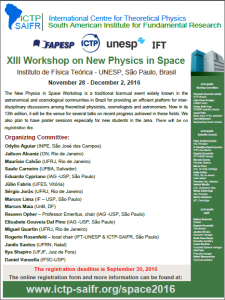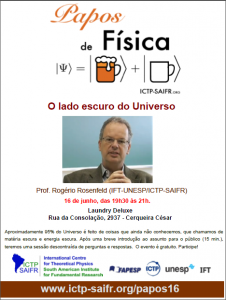Search Results
Alunos da América Latina se reúnem em curso sobre matéria escura
Mais de 80 alunos de pós-graduação de 17 países participaram do curso na Unesp
Por Marcos Jorge – Assessoria de Comunicação e Imprensa/UNESP
O Instituto de Física Teórica (IFT) recebeu entre os dias 27 de junho e 8 de julho a primeira Escola sobre Matéria Escura, que reuniu mais de 80 estudantes de pós-graduação de 17 países – a maioria deles da América Latina. A proposta do curso foi organizada pelo braço sul-americano do Centro Internacional de Física Teórica (ICTP-SAIFR), que está localizado nas dependências do IFT e tem como objetivo promover o estudo da física teórica na região.
O curso foi direcionado a pós-graduandos e seu conteúdo procurou contemplar as diferentes áreas que envolvem o estudo da matéria escura, bem como proposição de exercícios práticos e sessões de discussão para esclarecimento de dúvidas. Dois dos organizadores da Escola são pesquisadores do IFT: os professores Eduardo Pontón Bayona e Fabio Iocco. Além deles, os pesquisadores Gianfranco Bertone (Universidade de Amsterdã, na Holanda,) e Graciela Gelmini (Universidade da Califórnia em Los Angeles, Estados Unidos) também colaboraram remotamente na elaboração da programação e na seleção dos palestrantes brasileiros e estrangeiros.
Os organizadores argumentam que uma das motivações para organizar o curso de curta duração é o aumento nos últimos anos do número de estudantes interessados em estudar a matéria escura. “Às vezes o estudante não encontra alguém que trabalhe esse assunto na sua instituição e acaba perdendo a oportunidade de se aprimorar na área. A proposta do curso foi oferecer um conteúdo amplo para que o aluno tenha uma visão geral do assunto. A reunião de alunos estrangeiros também promove o diálogo com os colegas e pode ajudar na formação de uma comunidade no tema”, explica Pontón.
O pesquisador do IFT explica que o estudo da matéria escura abrange diversas áreas da Física, como cosmologia, física de partículas ou astrofísica. “Foi muito importante para nós organizadores encontrarmos pessoas que não fossem apenas pesquisadores qualificados, mas reconhecidamente bons professores em suas respectivas áreas”, explica Pontón, ele mesmo especialista em física de partículas.
Um desses professores é Pasquale Serpico, professor do LAPTh, a unidade de física teórica do Centro Nacional de Pesquisa Científica da França, que discutiu em sua palestra as evidências cosmológicas e astrofísicas para detecção da matéria escura. O italiano começou de fato a estudar o tema durante um pós-doc nos Estados Unidos. “O que me interessou foi justamente esse aspecto multidisciplinar de combinar conhecimentos de temas puramente astrofísicos com fundamentos da física de partículas”.
Serpico acredita que a matéria escura vem se tornando um tópico popular na comunidade científica muito por conta do desenvolvimento de novas tecnologias aplicadas em laboratórios como o Fermilab (laboratório de física de partículas de altas energias localizado nos EUA) ou de detecção direta subterrâneas. Segundo o pesquisador italiano, tais tecnologias atingiram tamanho nível de sensibilidade que permitem explorar novos elementos do espaço. “Atualmente estamos em um ponto em que mesmo quando um experimento não detecta algo, isso já é uma informação importante”, argumenta.
Outro organizador residente no IFT, Fabio Iocco acrescenta ainda que desde os anos 30 existe a noção de que falta matéria visível nos aglomerados de galáxias, porém foi apenas nas últimas décadas que se formou um consenso na comunidade científica mundial que essa matéria escura deveria estar fora do Modelo Padrão da física de partículas. “É neste momento que a matéria escura deixa de ser um problema unicamente da astrofísica para envolver também a comunidade de cientistas de física de partículas. Houve então uma grande inércia para estudar o tema e a injeção de recursos financeiros a partir mais ou menos dos anos 2000”, explica o astrofísico, que em 2015 publicou um artigo de grande repercussão na revista Nature Physics, em que comprova pela primeira vez a presença de matéria escura entre o Sol e o centro da Via Láctea.
Além dos pesquisadores Fabio Iocco e Eduardo Pontón, a equipe que se dedica ao estudo da matéria escura inclui também o professor Rogério Rosenfeld, que investiga cosmologia e a fenomenologia de partículas, além de integrar o Dark Energy Survey, um projeto internacional que estuda a dinâmica da expansão do universo.
A Escola recebeu no total 84 alunos, sendo 70 deles oriundos de instituições da América Latina. Os chilenos Felipe Rojas e Bastian Dias são estudantes ligados à Universidade Técnica Federico Santa Maria, na cidade de Valparaiso, e destacaram a capacidade do curso em cobrir os principais temas da matéria escura. “O aluno que estiver começando seus estudos no assunto teve um cenário geral bastante bom, e quem já tem alguma experiência pode afinar detalhes da pesquisa”, explica Rojas, que abordou a matéria escura em seu doutorado. “O curso também oferece a oportunidade de discutir o tema de pesquisa com outros colegas e fazer boas conexões”, aponta.
Estella Barbosa de Souza é brasileira, mas está fazendo seu doutorado na Yale University, nos Estados Unidos. Seu interesse pela matéria escura começou ainda na graduação – também realizada nos EUA -, o que a motivou a se aprofundar no tema para o doutorado. “A primeira semana de aulas tem sido mais teórica do que eu estou acostumada, uma vez que minha área de estudo é mais experimental. Ainda assim os professores tem sido ótimos na forma como transmitem o conteúdo”, explica a aluna que está envolvida em um projeto chamado DM Ice, que se dedica a detecção subterrânea de matéria escura em experimentos realizadas na Antarctica.
Gênero e Física Teórica
Entre palestras e exercícios sobre matéria escura, um tema se destacou da programação da Escola: uma discussão sobre Física e Gênero na América do Sul. A proposta de debater a representatividade masculina e feminina no campo ocupou quase duas horas do cronograma da terça-feira, dia 5, e partiu de uma iniciativa das professoras e dos organizadores do curso.
“A motivação desse debate foi chamar a atenção para questões que as mulheres enfrentam no estudo da Física na América do Sul e em outras partes do mundo”, explica a professora Nassim Borzognia, da Universidade de Amsterdã, que conduziu os debates ao lado das colegas Francesca Calore, também professora da instituição holandesa, Manuela Vecchi, do Instituto de Física de São Carlos (USP), e Nayara Fonseca, do Instituto de Física da USP, em São Paulo.
“Estávamos interessadas especialmente em ouvir as experiências dos estudantes em relação a tratamentos desiguais durante seus estudos e discutir, em um ambiente aberto, alguns dos preconceitos conscientes e inconscientes que as alunas enfrentam”, aponta. Durante o encontro foram apresentaram dados sobre a proporção de homens e mulheres no curso e convidaram as pessoas presentes na audiência a comparar com a proporção em suas respectivas instituições.
De forma geral, os alunos de diferentes países apontaram um predomínio masculino nos programas de Física Teórica, seja entre os estudantes ou no corpo discente. Os depoimentos levantaram questionamentos sobre, por exemplo, o motivo e o momento em que as mulheres se desinteressam pelo estuda da Física.
“Este não é uma discussão que nós costumamos ver nas escolas de Física e me surpreendeu de forma positiva ver este tipo de debate aqui”, afirmou Manoela Saez, doutoranda em Astronomia da Universidade Nacional de la Plata, na Argentina. “O que eu noto na Argentina é que também existem mais homens que mulheres estudando Física. Apenas o curso de Astronomia é mais equilibrado”.
Veja também a versão digital do Jornal da Unesp: http://www.unesp.br/jornal
Continue Reading | Comments Off on Alunos da América Latina se reúnem em curso sobre matéria escura
Astronomia de ondas gravitacionais
O amanhecer de uma nova ciência
Por Agência FAPESP
Astronomia de ondas gravitacionais: O amanhecer de uma nova ciência’ será o tema do Papos de Física do Instituto Sul-Americano para Pesquisa Fundamental (ICTP-SAIFR) no dia 4 de agosto de 2016.
O seminário será ministrado pelo professor Riccardo Sturani, do Instituto de Física Teórica da Unesp e do ICTP-SAIFR.
Entre setembro de 2015 e janeiro de 2016, o observatório LIGO efetuou duas detecções de ondas gravitacionais produzidas pela fusão de dois buracos negros.
“Ondulações no espaço-tempo, essas ondas viajam à velocidade da luz e trazem importantes informações sobre as fontes que causaram essa emissão. Marco histórico na física e astronomia, essa descoberta confirmou uma predição da teoria da relatividade geral de Einstein e deu início a um novo campo de pesquisa, a astronomia gravitacional”, disse Sturani, que é membro da LIGO Scientific Collaboration.
A palestra será no Laundry Deluxe, rua da Consolação, 2.937, Cerqueira César, São Paulo.
Evento de divulgação científica idealizado pelo ICTP-SAIFR, a série Papos de Física é uma oportunidade de conhecer um pouco mais sobre assuntos instigantes e as mais recentes descobertas científicas na área de Física. Com conteúdo acessível ao público, os seminários proporcionam debates instigantes sobre tópicos de física com quem faz física.
Os próximos temas serão “Somos um Holograma?” (01/09) e “O átomo do átomo” (06/10). Em 6 novembro, haverá uma edição especial, com David Gross, Nobel de Física de 2004.
O ICTP-SAIFR tem apoio da FAPESP.
Mais informações: www.ictp-saifr.org/papos16.
Fonte: http://www.unesp.br/portal#!/noticia/22650/astronomia-de-ondas-gravitacionais/
Continue Reading | Comments Off on Astronomia de ondas gravitacionais
UNESP hosts School on Dark Matter for 80 Latin American Graduate students
by Marcos Jorge – Assessoria de Comunicação e Imprensa/UNESP
The Institute of Theoretical Physics hosted between June 27th and July 8th a School on Dark Matter for more than 80 students, from 17 different countries – most from Latin America. The activity was an initiative of the South American Institute for Fundamental Research (SAIFR), the regional branch of the prestigious International Center for Theoretical Physics, located in Trieste, Italy.
The organizers argue that one of the motivations to create the School is the growing interest that this topic has aroused in the recent years. “Sometimes, it is difficult for Latin American students to find in his or her institution someone who works with Dark Matter and a good the opportunity to improve the field is missed”, explains professor Eduardo Pontón, from UNESP.
Pontón explains that Dark Matter is a field that involves several areas such as cosmology, astrophysics or particle physics. “In order to assemble the best faculty, the team searched not only for experienced researchers but also for professors who were well known for their teaching abilities”, Pontón says.
Pontón, a particle physics expert, is one of the School organizers, along with Gianfranco Bertone (GRAPPA – University of Amsterdam, The Netherlands), Graciela Gelmini (UCLA-Los Angeles, USA) and Fabio Iocco, also a professor at the Institute of Theoretical Physics of UNESP.
According to professor Iocco, since the 1930s, scientists understand that there is visible matter missing in the galaxies, but it was only in the last decades that the scientific community reached a consensus that this dark matter is not part of the Standard Model of particle physics. “That is the moment when Dark Matter is no longer only an Astrophysics topic, but also an issue for the particle physics community. From that moment on, there was a big inertia to study Dark Matter and a great injection of funds”, he explains.
Iocco is an Astrophysicist that in the beginning of 2015 wrote an article entitled Evidence for dark matter in the inner Milky Way published on Nature Physics. The article proved for the first time the presence of Dark Matter in the innermost region of the Milky Way.
Continue Reading | Comments Off on UNESP hosts School on Dark Matter for 80 Latin American Graduate students
Físicos descobrem vibrações inesperadas em nanomaterial
Pós-doc no Instituto de Física Teórica da Unesp participa da pesquisa
Por Igor Zolnerkevic | Revista Pesquisa FAPESP
Um grupo de físicos brasileiros observou pela primeira vez em detalhe como os átomos vibram nas bordas de um material de dimensões nanométricas feito exclusivamente a partir do elemento químico fósforo. Conhecido como fósforo negro, esse material não é encontrado na natureza. Foi sintetizado pela primeira vez em 1914, mas suas propriedades com potencial aplicação em nanotecnologia só começaram a ser descobertas um século mais tarde.
Em um estudo publicado nesta quinta (14/7) na revista Nature Communications, a equipe coordenada pelo físico brasileiro Christiano de Matos descreve uma anomalia no padrão de vibrações que jamais havia sido observada em blocos tão diminutos de fósforo negro nem em outros materiais com dimensões nanométricas, como o grafeno, formado por uma só camada de átomos de carbono e uma das grandes promessas da nanotecnologia. “As bordas do grafeno apresentam algumas propriedades peculiares, mas as vibrações atômicas são iguais às do restante do cristal”, conta Matos, físico do Centro de Pesquisas Avançadas em Grafeno, Nanomateriais e Nanotecnologias (MackGraphe) da Universidade Presbiteriana Mackenzie. “Observamos algo novo no fósforo negro.”
Segundo o pesquisador, por ora é difícil dizer se essas alterações na vibração podem ajudar ou atrapalhar o design de um dispositivo nanotecnológico, como um transistor ou um sensor de luz. “O que se torna claro”, diz, “é que o projeto de qualquer dispositivo terá de levar essas vibrações de borda em consideração.”
Na escala dos objetos medidos em milionésimos de milímetros (nanômetros), as vibrações atômicas estão estreitamente relacionadas a várias propriedades dos materiais, em especial, à dissipação de calor. “São as vibrações que carregam o calor de um lado para outro do material”, explica o físico.
Desde que as primeiras propriedades com potencial uso em nanotecnologia do fósforo negro começaram a ser identificadas, em 2014, o interesse dos pesquisadores de diversas áreas por esse material vem crescendo. Chamam a atenção a sua capacidade de conduzir eletricidade e, principalmente, a de emitir e absorver luz em vários comprimentos de onda, propriedade que varia segundo a espessura do cristal de fósforo negro. São essas propriedades que, de acordo com especialistas, podem tornar o seu uso mais vantajoso do que o do grafeno em nanofotônica.
Em termos estruturais, o fósforo negro é semelhante à grafite, o mesmo material usado em lápis. Tanto um quanto outro são formados por folhas de apenas um átomo de espessura empilhadas umas sobre as outras – as camadas monoatômicas de fósforo são chamadas de fosforeno, e as de carbono recebem o nome de grafeno.
Mas as propriedades especiais desses materiais aparecem sob condições distintas. A alta resistência mecânica e a boa capacidade de conduzir calor ou eletricidade do carbono aparecem principalmente quando este elemento químico está disposto em uma folha de um só átomo de espessura – ou seja, encontra-se na forma de grafeno. Já com o fósforo negro é diferente. Suas propriedades se tornam evidentes à medida que os pesquisadores esfoliam o material e chegam a uma dezena (ou até menos) de camadas empilhadas. Essa característica pode permitir controlar mais facilmente as propriedades do material simplesmente adicionando ou eliminando camadas.
Em experimentos conduzidos no MackGraphe, o estudante de doutorado Henrique Ribeiro, orientado por Matos e pelos físicos Marcos Pimenta, da Universidade Federal de Minas Gerais, e Eunézio Antônio de Souza (Thoróh), do MackGraphe, fez feixes de laser incidirem sobre amostras de fósforo negro compostas de diferentes números de camadas atômicas, com espessura variando de 6 a 300 nanômetros. Parte dessa luz é absorvida e parte é espalhada pelos átomos do material. A luz absorvida fornece energia para os átomos vibrarem, alterando as propriedades – em especial, a frequência e a polarização – da luz espalhada.
Em seguida, os pesquisadores compararam as medições feitas no experimento com os resultados de simulações feitas pelo físico Cesar Pérez Villegas, que faz estágio de pós-doutorado sob a supervisão de Alexandre Rocha no Instituto de Física Teórica da Universidade Estadual Paulista (Unesp), em São Paulo. Da comparação, os físicos deduziram como os átomos vibravam ao receber o laser e concluíram que, nas bordas do fósforo negro, os átomos oscilavam de maneira específica, distinta daquela dos átomos do restante do material. Essas vibrações de borda apareceram em todas as amostras, independentemente de sua espessura.
Experimentos semelhantes ao feito agora com o fósforo negro já haviam sido realizados com o grafeno e mostrado que, embora seus átomos vibrem da mesma maneira tanto na borda como em seu interior, a luz espalhada nas bordas deste material pode apresentar frequência diferente da espalhada por seu miolo. A vibração dos átomos viaja pelo material na forma de ondas. No grafeno, a borda funciona como um espelho em que a onda bate e volta refletida. É essa reflexão que modifica a frequência da luz espalhada. Já no fósforo negro, a vibração diferente é explicada por um leve deslocamento dos átomos na borda das camadas de fosforeno. “No fosforeno, os átomos da borda têm uma posição de equilíbrio diferente da dos átomos do meio do material”, conta Matos. “Isso os faz vibrar de modo distinto.”
As pesquisas tiveram apoio da FAPESP por meio dos projetos Grafeno: fotônica e optoeletrônica; Efeitos plasmônicos e não-lineares em grafeno acoplado a guias de onda ópticos; e ICTP Instituto Sul-americano para Pesquisa Fundamental: um centro regional para física teórica.
O artigo Edge phonons in black phosphorus, assinado por Ribeiro, H. B. et al. e publicado na Nature Communications de 14 julho 2016 está acessível no endereço www.nature.com/ncomms/2016/160714/ncomms12191/abs/ncomms12191.html
Fonte: http://www.unesp.br/portal#!/noticia/22629/fisicos-descobrem-vibracoes-inesperadas-em-nanomaterial/
Continue Reading | Comments Off on Físicos descobrem vibrações inesperadas em nanomaterial
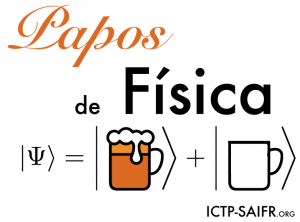
Astronomia de ondas gravitacionais:
O amanhecer de uma nova ciência
Riccardo Sturani
04 de agosto, das 19h30 ás 21h
Local: Laundry Deluxe – Rua da Consolação, 2937, Cerqueira César
Veja as fotos dessa edição
Entre setembro de 2015 e janeiro de 2016 o observatório LIGO efetuou duas detecções de ondas gravitacionais produzidas pela fusão de dois buracos negros. Ondulações no espaço-tempo, essas ondas viajam à velocidade da luz e nos trazem importantes informações sobre as fontes que causaram esta emissão. Marco histórico na física e astronomia, essa descoberta confirmou uma predição da teoria da relatividade geral de Einstein e deu início a um novo campo de pesquisa, a astronomia gravitacional.
SOBRE:
O Papos de Física surge como uma oportunidade para entrar em contato com temas relevantes e as mais recentes descobertas científicas na área de física. Com seminários curtos (15-20 min) seguido de debates, esta atividade será feita de forma descontraída e com conteúdo acessível ao público.
O PALESTRANTE:
Riccardo Sturani atua como pesquisador na área de Ondas Gravitacionais. É atualmente Jovem Pesquisador FAPESP no ICTP South American Institute for Fundamental Research e Instituto de Física Teórica-UNESP, além de ser membro da colaboração científica LIGO. Riccardo trabalha na modelagem e análise de dados de sinais de sistemas estelares binários coalescentes. A modelagem é particularmente importante porque as ondas gravitacionais têm interação muito fraca com a matéria, tornando necessárias, além de detetores de alto desempenho, técnicas de análises eficazes e uma modelagem teórica precisa dos sinais.
Poster
![]()
Continue Reading | Comments Off on

13 Maneiras de Morrer com um Buraco Negro
Rodrigo Nemmen (IAG-USP)
março, das 19h30 às 21h
Local: Laundry Deluxe – Rua da Consolação, 2937, Cerqueira César
Por que os buracos negros são tão fascinantes? Será por causa da complicada física envolvida? Do seu incrível poder destrutivo? Da maneira estranha pela qual eles distorcem as nossas noções de realidade, espaço e tempo? Qualquer que seja a explicação, o fato é que os buracos negros são perigosos. Há várias maneiras de morrer com um buraco negro e nesta apresentação discutirei algumas delas. Algumas são simples, outras são verdadeiramente bizarras. O evento é gratuito. Participe!
SOBRE:
O Papos de Física surge como uma oportunidade para entrar em contato com temas relevantes e as mais recentes descobertas científicas na área de física. Com seminários curtos (15-20 min) seguido de debates, esta atividade será feita de forma descontraída e com conteúdo acessível ao público.
A PALESTRANTE:
Rodrigo Nemmen é professor de astrofísica na Universidade de São Paulo, membro afiliado da Academia Brasileira de Ciências e foi pesquisador na NASA. Suas pesquisas têm buscado desvendar os segredos dos fenômenos mais violentos do universo — em particular os buracos negros.
Poster: Faça o download do pdf aqui!
Próximos encontros:
Em breve disponibilizaremos a programação do 1o semestre de 2017.
Encontros anteriores:
6 de dezembro – Renata Funchal (FMA-USP) – Neutrinos: de quimeras a ases do Universo
6 de novembro (domingo, 14h00, auditório do IFT-UNESP): David Gross (Prêmio Nobel de Física 2004), Gabriela Gonzalez (Porta-voz da colaboração científica LIGO), Luiz Davidovich (Presidente da Acad. Brasileira das Ciências)
6 de outubro – Ricardo Matheus (IFT-UNESP) – O átomo do átomo
1 de setembro – Pedro Vieira (ICTP-SAIFR & Perimeter I.) – Somos um Holograma?
4 de agosto – Riccardo Sturani (ICTP-SAIFR & IFT-UNESP, membro do LIGO) – Astronomia de ondas gravitacionais: o amanhecer de uma nova ciência
16 de junho – Rogério Rosenfeld (IFT-UNESP & ICTP-SAIFR) – O lado escuro do Universo
![]()
Continue Reading | Comments Off on
Info
Piattella
Siffert
Santos
Santos
Vargas
Rivera
Fong
Bernal
Poulin
Rios
Bozorgnia
Dijkstra
Serpico
CIRELLI
Ogawa
Coderre
Batista
Bozorgnia
Calore
White
Sturani
Tonero
Silverwood
Kiryluk
Vecchi
Pavluchenko
Chimenti
Vecchi
Contreras
Delliou
SUSY)
Johnson
Marozzi
Markkanen
Heisel
Matheus
Fichet
Palomares-Ruiz
Arbeletche
Yamazaki)
Güler)
Cely
Continue Reading | Comments Off on Info
XIII Workshop on New Physics in Space
![]()
Start time: November 28, 2016
Ends on: December 1, 2016
Location: São Paulo, Brazil
Venue: IFT-UNESP
Description:
The New Physics in Space Workshop is a traditional biannual event widely known in the astronomical and cosmological communities in Brazil for providing an exceptionally efficient platform for inter-disciplinary discussions among theoretical physicists, cosmologists and astronomers. Now in its 13th edition, it will be the venue for several talks on recent progress achieved in these fields. There will be poster sessions especially for new students in the area. Abstracts can be written and presentations can be given in English or Portuguese. There will be no registration fee.
Workshop Program: PDF version updated on Nov. 30
| Start | End | Monday, Nov. 28 (video 1) (video 2) (video 3) | Tuesday, Nov. 29 (video 1)(video 2) | Wednesday, Nov. 30 (video 1) (video 2) (video 3) | Thursday, Dec. 1 (video 1) (video 2) (video 3) | ||||
| 9:00 | 9:20 | REGISTRATION | |||||||
| 9:20 | 9:30 | R. Rosenfeld | Welcome | ||||||
| 9:30 | 9:55 | R. Opher | Opening | D. Rodrigues | Evidences against cuspy dark matter halos in large galaxies (PDF) | S. Vitenti | Numerical Cosmology with NumCosmo (PDF) | O. Aguiar | O que aprendemos com as primeiras detecções de ondas gravitacionais? (PDF) |
| 10:00 | 10:25 | I. Shapiro | Super-renormalizable models of quantum gravity (PDF) | E. Karukes | The universal rotation curve of dwarf disk galaxies (PDF) | M. Lima Vitenti | Calibrating the Planck Cluster Mass Scale with CLASH (PDF) | M. Maia | Detecting Gravitational Waves from a Gravitational Compass (PDF) |
| 10:30 | 10:55 | W. Corrêa de Lima | Mode-sum construction of the graviton two-point function in de Sitter space-time (PDF) | M. Castaño | Dark Matter distribution in the Galactic bulge (PDF) | V. Busti | Model-independent tests in cosmology (PDF) | C. Chirenti | Effect of a variable cosmological constant on black hole quasinormal modes (PDF) |
| 11:00 | 11:30 | COFFEE BREAK | |||||||
| 11:30 | 11:55 | J. Ademir Lima | Is ΛCDM an Effective CCDM Cosmology? (PDF) | F. Iocco | Particle DM constraints: the effect of Galactic uncertainties | J. Fabris | Viscous cosmology (PDF) | J. Rodrigues | On Inflation, Neutrino masses and the strong CP problem in a 3-3-1 model (PDF) |
| 12:00 | 12:25 | B. Giacchini | Low-energy effects in a superrenormalizable gravity model with real and complex massive poles (PDF) | M. Vecchi | What have we learned after 5 years aboard the ISS? An overview of AMS-02 results | L. Casarini | Cosmic discordance in decaying vacuum models? (PDF) | M. Aguena | Effects of Completeness and Purity on Cluster Dark Energy Constraints (PDF) |
| 12:30 | 14:00 | LUNCH | |||||||
| 14:00 | 14:25 | M. Cunha e Mello | Cosmological black holes from conformal transformations of static solutions (PDF) | E. Dal Pino | Particle Acceleration and Gamma Ray Emission around Black Hole Sources (PDF) |
Jorge Meléndez
|
IFT-Colloquium: The search for Solar Twins and Earth 2.0
|
Jeff Newman | The future of ground-based astronomy in the US |
| 14:30 | 14:55 | A. da Silva | On the formation of Universal Horizons (PDF) | J. Braga | Perspectives for the MIRAX mission (PDF) | ||||
| 15:00 | 15:25 | M. Quartin | The Cosmic Supernova Recycling Program (PDF) | D. Teixeira | GRMHD simulations of Sub Eddington Accretion Flows using full radiation transport (PDF) | R. Sturani | The effect of matter structure on the gravitational waveform (PDF) | ||
| 15:30 | 16:30 | COFFEE BREAK & POSTER | |||||||
| 16:30 | 19:00 | DISCUSSION | |||||||
Photos and drawings from Sarah White:
Abstracts:
Speakers:
- Michel Aguena (USP-SãoPaulo, Brazil)
- Odylio Denys de Aguiar (INPE-São Paulo, Brazil)
- João Braga (INPE-São Paulo, Brazil)
- Vinicius Busti (USP-São Paulo, Brazil)
- Luciano Casarini (UFES-Vitória, Brazil)
- María Benito Castaño (IFT-UNESP-São Paulo, Brazil)
- Cecilia Bertoni Martha Hadler Chirenti (UFABC-Santo André, Brazil)
- Júlio César Fabris (UFES-Vitória, Brazil)
- Breno Loureiro Giacchini (CBPF-Rio de Janeiro, Brazil)
- Luiz Filipe de Oliveira Guimarães (CBPF-Rio de Janeiro, Brazil)
- Fabio Iocco (ICTP-SAIFR/IFT-UNESP-São Paulo, Brazil)
- Ekaterina Karukes (ICTP-SAIFR-São Paulo, Brazil)
- William Couto Corrêa de Lima (UFABC-Santo André, Brazil)
- José Ademir Sales Lima (IAG-USP-São Paulo, Brazil)
- Marcos Duarte Maia (UnB-Brasília, Brazil)
- Marina Machado Cunha e Mello (UFABC-Santo André, Brazil)
- Jeff Newman (U. Pittsburgh, USA)
- Reuven Opher (IAG-USP-São Paulo, Brazil & Columbia U., USA)
- Elisabete de Gouveia Dal Pino (IAG-USP-São Paulo, Brazil)
- Miguel Quartin (UFRJ-Rio de Janeiro, Brazil)
- Davi Cabral Rodrigues (UFES-Vitória, Brazil)
- Jamerson Gillis Batista Rodrigues (UFPB-João Pessoa, Brazil)
- Ilya L. Shapiro (UFJF-Juiz de Fora, Brazil)
- Alan Maciel da Silva (UFABC-Santo André, Brazil)
- Riccardo Sturani (IIP-Natal, Brazil)
- Danilo Morales Teixeira (U. Maryland, USA)
- Manuela Vecchi (IFSC-USP-São Carlos, Brazil)
- Mariana Penna Lima Vitenti (CBPF-Rio de Janeiro, Brazil)
- Sandro Dias Pinto Vitenti (CBPF-Rio de Janeiro, Brazil)
Organizing Committee:
- Odylio Aguiar (INPE, São José dos Campos)
- Jailson Alcaniz (ON, Rio de Janeiro)
- Maurício Calvão (UFRJ, Rio de Janeiro)
- Saulo Carneiro (UFBA, Salvador)
- Eduardo Cypriano (IAG -USP, São Paulo)
- Júlio Fabris (UFES, Vitória)
- Sérgio Jorás (UFRJ, Rio de Janeiro)
- Marcos Lima (IF – USP, São Paulo)
- Marcos Maia (UnB, DF)
- Reuven Opher – Professor Emeritus, chair (IAG -USP, São Paulo)
- Elisabete Gouveia Dal Pino (IAG -USP, São Paulo)
- Miguel Quartin (UFRJ, Rio de Janeiro)
- Rogerio Rosenfeld – local chair (IFT-UNESP& ICTP-SAIFR, São Paulo)
- Janilo Santos (UFRN, Natal)
- Ilya Shapiro (UFJF, Juiz de Fora)
- Daniel Vanzella (IFSC-USP, São Carlos)
Announcement
Additional Information:
List of Participants: Updated on Nov 24
Poster presentation: Participants who are presenting a poster MUST BRING THE POSTER PRINTED. The poster size should be at most 1,5m x 1m.
Hotel Recommendations:
The Universe Flat
Rua Pamplona, 83 – Jardim Paulista – São Paulo
Rates: R$ 274 + 5% (single) or R$ 324 + 5% (double), this is a special rate for Unesp.
Reservation: In order to get this rate you have to send an email to secretary@ictp-saifr.org
Hotel webpage: http://www.intercityhoteis.com.br/hoteis/hotel-the-universe/
This is the main hotel of the workshop.
How to reach the institute from The Universe Flat: Click here
Paulista Flat
Alameda Campinas, 105 – Bela Vista – São Paulo
Rates: You can check the rates and availability here
Reservation: Directly with the hotel. A credit card will be requested.
Hotel webpage: http://www.paulistaflat.com.br/home
How to reach the institute from Paulista Flat: Click here
Paulista Wall Street Suites
Rua Itapeva, 636 – Bela Vista – São Paulo
Rates: You can check the rates and availability here
Reservation: Directly with the hotel. A credit card will be requested.
Hotel webpage: http://www.wallstreet.com.br/
How to reach the institute from Paulista Wall Street Suites: Click here
Turiassu Hotel
Rua Turiassu, 328 – Perdizes – São Paulo
Rates: You can check the rates here
Reservation: Here
Hotel Webpage: http://www.hotelturiassu.com.br
How to reach the institute from Turiassu Hotel: Click here
Ibis Budget Paulista
Rua da Consolação 2303 – Consolação – São Paulo
Rates: You can check the rates and availability here
Reservation: Directly with the hotel. A credit card will be requested.
Hotel Webpage: http://www.ibis.com/gb/hotel-5323-ibis-budget-sao-paulo-paulista/index.shtml
How to reach the institute from Ibis Budget Paulista: Click here
Red Monkey Hostel
Rua Vitorino Carmilo, 664 – São Paulo
Rates: You can check the rates here
Reservation: You can request the reservation through the email secretary@ictp-saifr.org or directly on their webpage.
Hostel webpage: http://www.redmonkeyhostel.com.br/
Hostel Alice
Rua Harmonia, 1275 – Vila Madalena – São Paulo
Rates: You can check the rates and availability here
Reservation: Directly with the hostel. A credit card will be requested.
Hostel webpage: http://www.hostelalice.com.br/site/br/
How to reach the institute from Hostel Alice: Click here–
Contact: secretary@ictp-saifr.org
Continue Reading |
Comments Off on
Ondas gravitacionais detectadas em outro par de buracos negros
Pesquisadores no Brasil contribuem para a descoberta
Por Assessoria de Comunicação e Imprensa/UNESP
No dia 26 de dezembro de 2015, à 01:38:53, horário de Brasília, cientistas observaram ondas gravitacionais, ondulações no espaço tempo, pela segunda vez.
As ondas gravitacionais foram detectadas simultaneamente nos Observatórios para detecção de Ondas Gravitacionais por Interferometria Laser (sigla LIGO em inglês), localizados em Livingston, Estado da Louisiana, e Hanford, em Washington, nos EUA.
Os observatórios LIGO são financiados pela Fundação Nacional da Ciência (sigla NSF em inglês) e foram pensados, construídos e são operados pelo Caltech and MIT. A descoberta, aceita para publicação na revista científica Physical Review Letters, foi efetuada pela Colaboração Científica LIGO, que inclui a colaboração GEO e o Australian Consortium for Interferometric Gravitational Astronomy, e a colaboração Virgo usando dados dos dois detectores LIGO.
Ondas Gravitacionais carregam informações sobre suas próprias origens e sobre a natureza da gravidade que não poderiam ser obtidas de outra maneira. Físicos concluíram que essas ondas gravitacionais foram produzidas durante os últimos instantes da fusão de dois buracos negros – de massa respectivamente 14 e 8 vezes o nosso Sol – que produziram um buraco negro único e mais massivo, com massa 21 vezes maior do que a do Sol.
“É importante notar que esses buracos negros são muito menos massivos que aqueles observados na primeira detecção”, falou Gabriela Gonzalez, a porta-voz da Colaboração Científica LIGO (sigla LSC em inglês) e professora de física e astronomia da Universidade do Estado da Lousiana. “Graças a suas massas menores, quando comparadas com aquelas da primeira detecção, eles passaram mais tempo – cerca de um segundo – na banda sensível dos detectores. É um início promissor no mapeamento das populações de buracos negros de nosso Universo”.
Durante a fusão, que ocorreu há aproximadamente 1.4 bilhões de anos, uma quantidade de energia equivalente mais o menos à massa do Sol foi convertida em ondas gravitacionais. O sinal detectado foi originado das ultimas 27 órbitas dos buracos negros antes da colisão. A partir do tempo de chegada dos sinais – o detector do Livingston mediu as ondas 1.1 milissegundos antes do detector de Hanford — a posição da fonte no céu pôde ser aproximadamente determinada.
“Em um futuro próximo, Virgo, o interferômetro Europeu, se juntará à rede de detectores de ondas gravitacionais e irá melhorar nossa contribuição para a astronomia de múltiplos mensageiros,” disse Fulvio Ricci, porta-voz da Colaboração Virgo. “Os três interferômetros juntos permitirão uma localização muito melhor dos sinais no céu”.
A primeira detecção das ondas gravitacionais, anunciada no dia 11 de fevereiro de 2016, foi um marco histórico na física e na astronomia; confirmou uma importante predição da teoria da Relatividade Geral de Einstein (1915) e foi o marco inicial para o novo campo de pesquisa em astronomia gravitacional.
A segunda detecção “legitimou o ‘O’ para Observatório em LIGO”, disse Albert Lazzarini (Caltech), diretor dos laboratórios do LIGO. “Com a detecção de dois eventos de impacto nos primeiros quatro meses de coleta de dados, podemos começar a fazer predições sobre quantas vezes poderemos escutar ondas gravitacionais no futuro. LIGO está nos levando para um novo modo de observar alguns dos eventos mais escuros e mais energéticos em nosso universo”.
“Estamos começando a ter uma ideia do tipo de informações astrofísicas que só podem vir de detectores de ondas gravitacionais”, falou o diretor do MIT, David Shoemaker, que dirigiu o programa de construção dos detectores avançados LIGO.
Ambas as descobertas foram possíveis graças às capacidades avançadas do Advanced LIGO, cujas melhorias significativas aumentaram a sensibilidade dos instrumentos em comparação à primeira geração dos detectores LIGO, o que permitiu um aumento significativo no volume do universo observado.
“Com o advento do Advanced LIGO, já esperávamos que os pesquisadores eventualmente detectassem fenômenos inesperados, mas essas duas detecções ultrapassaram nossas expectativas”, falou o diretor do NSF France, A. Córdova. “Este investimento de 40 anos da NSF nesta pesquisa básica já está fornecendo novas informações sobre a natureza do universo escuro”.
A próxima coleta de dados do Advanced LIGO começará nos últimos meses de 2016. Até lá melhorias adicionais na sensibilidade dos detectores são esperadas, o que permitirá ao LIGO atingir de 1.5 até 2 vezes mais volume do universo do que atualmente. Espera-se que o detector Virgo possa coletar dados juntos com os LIGOs na segunda metade da próxima coleta de dados.
A pesquisa do LIGO é efetuada pela Colaboração Científica LIGO (sigla LSC em inglês), um grupo de mais de 1 mil cientistas de Universidades dos Estados Unidos e de mais 14 países, entre eles o Brasil. Mais de 90 universidades e instituições de pesquisa no mundo desenvolvem tecnologia de detecção e análise de dados; aproximadamente 250 estudantes são membros importantes da colaboração. A rede de detectores do LSC incluem os interferômetros LIGO e o detector GEO600.
A pesquisa de Virgo é efetuada pela Colaboração Virgo, composta por mais de 250 físicos e engenheiros que pertencem a 19 grupos europeus diferentes: seis do Centro National da Pesquisa Científica (sigla CNRS em francês) na França; oito do Instituto Nacional de Física Nuclear (sigla INFN em itáliano) na Itália; dois na Holanda com o Nikhef, o Wigner RCP na Hungria; o grupo POLGRAW na Polônia e o Observatório Gravitacional Europeu (sigla EGO em inglês), o laboratório que sedia o detector Virgo perto de Pisa, na Itália.
O NSF lidera o financiamento para o Advanced LIGO. Organizações financiadoras na Alemanha (Max Placnk Society), no Reino Unido (Science and Technology Facilities Council, STFC) e Austrália (Australian Research Council) também deram contribuições significativas ao projeto.
Várias tecnologias chave que permitiram maior sensibilidade ao Advanced LIGO foram desenvolvidas e testadas pela colaboração Anglo-Alemã GEO. Recurso computacionais importantes foram disponibilizados pelo cluster de computadores Atlas do AEI de Hannover, o laboratório do LIGO, a Universidade de Syracuse, o cluster ARCCA da Universidade de Cardiff, a Universidade de Winsconsin-Milwaukee, e pelo Open Science Grid do qual a UNESP faz parte. Várias Universidades desenharam, construíram e testaram componentes chaves e técnicas para o Advanced LIGO: a Australian National University, a Universidade de Adelaide, a Universidade do Western Australia, a Universidade da Florida, Stanford University, Columbia University na cidade de New York, e a Louisiana State University. O grupo GEO inclui cientistas do Max Planck Institute for Gravitational Physics (Albert Einstein Institute, AEI), Leibniz Universität Hannover, em parceria com a Universidade de Glasgow, Cardiff University, a Universidade de Birmingham, outras universidades no Reino Unido e na Alemanha, e a Universidade das Ilhas Baleares na Espanha.
Pesquisadores no Brasil contribuindo para a descoberta
Existem dois grupos no Brasil, ambos no Estado de São Paulo, que participam oficialmente da LSC. O primeiro deles está na Divisão de Astrofísica do Instituto Nacional de Pesquisas Espaciais (INPE), em São José dos Campos, órgão do Ministério da Ciência, Tecnologia e Inovação e conta com seis membros. O outro grupo está no ICTP (Instituto de Pesquisa Básica da América do Sul), filiado ao Centro Internacional de Física Teórica (sigla ICTP-SAIFR em inglês), localizado no IFT/UNESP, na cidade de São Paulo.
O grupo do INPE, dirigido por Odylio Aguilar, trabalha no aperfeiçoamento da instrumentação de isolamento vibracional do LIGO, na sua futura operação com espelhos resfriados e na caracterização dos detectores, buscando determinar suas fontes de ruído.
Já o grupo do ICTP-SAIFR/IFT-UNESP, dirigido por Riccardo Sturani, trabalha na modelagem e análise dos dados de sinais de sistemas estelares binários coalescentes, como os dois eventos detectados até agora. A modelagem é particularmente importante porque as ondas gravitacionais interagem fracamente com a matéria, tornando necessário, além de detectores de alto desempenho, técnicas de análises eficazes e uma modelagem teórica precisa dos sinais.
Links para scientific papers
https://dcc.ligo.org/LIGO-P1600088/public
http://journals.aps.org/prl/abstract/10.1103/PhysRevLett.116.241103
Contatos locais
Riccardo Sturani
+55 11 3393 78 50
sturani@ift.unesp.br
Odylio Aguiar
+55 12 3208 7213
odylio.aguiar@inpe.br
Contatos internacionais:
MIT
Kimberly Allen
Director of Media Relations
Deputy Director, MIT News Office
617-253-2702 (office)
617-852-6094 (cell)
allenkc@mit.edu
Caltech
Whitney Clavin
Senior Content and Media Strategist
626-390-9601 (cell)
wclavin@caltech.edu
NSF
Ivy Kupec
Media Officer
703-292-8796 (Office)
703-225-8216 (Cell)
ikupec@nsf.gov
LIGO Scientific Collaboration
Mimi LaValle
External Relations Manager
Louisiana State University
225-439-5633 (Cell)
http://mlavall@lsu.edu
Virgo
Fulvio Ricci
Roma +39 06 49914261 (Office)
Cascina +39 050 752 345 (Office)
+39 348 3187354 (Cell)
fulvio.ricci@roma1.infn.it
GEO
Susanne Milde
Phone +49 331 583 93 55
Mobile: +49 172 3931349
milde@mildemarketing.de
UK Science and Technology Facilities Council
Terry O’Connor
+44 1793 442006
+44 77 68 00 61 84 (Cell)
terry.o’connor@stfc.ac.uk
Max Planck Institute for Gravitational Physics Hannover
Benjamin Knispel
Press Officer
+49 511 762 19104
benjamin.knispel@aei.mpg.de
Continue Reading | Comments Off on Ondas gravitacionais detectadas em outro par de buracos negros

O Lado Escuro do Universo
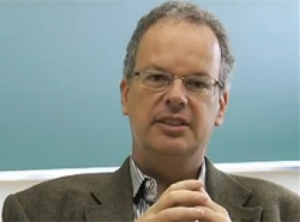
Rogério Rosenfeld
16 de junho, das 19h30 ás 21h
Local: Laundry Deluxe – Rua da Consolação, 2937, Cerqueira César
Aproximadamente 95% do Universo é feito de coisas que ainda não conhecemos, que chamamos de matéria escura e energia escura. Conversaremos sobre como chegamos a essa conclusão surpreendente através de observações astronômicas e o que a Física tem sugerido como possíveis explicações para o lado escuro do Universo.
SOBRE:
O Papos de Física surge como uma oportunidade para entrar em contato com temas relevantes e as mais recentes descobertas científicas na área de física. Com seminários curtos (15-20 min) seguido de debates, esta atividade será feita de forma descontraída e com conteúdo acessível ao público.
O PALESTRANTE:
Rogério Rosenfeld atua como pesquisador na área de Fenomenologia de Partículas Elementares e Cosmologia. É atualmente diretor do Instituto de Física Teórica-UNESP e vice-diretor do ICTP South American Institute for Fundamental Research. Em 2014, Rogério foi agraciado com a segunda colocação no Prêmio Jabuti de literatura brasileira na categoria ciências naturais, tecnologia e ciências da computação por seu livro “O cerne da matéria – A aventura científica que levou à descoberta do bóson de Higgs”.
FOTOS
- clique aqui
Poster
![]()
Continue Reading | Comments Off on
